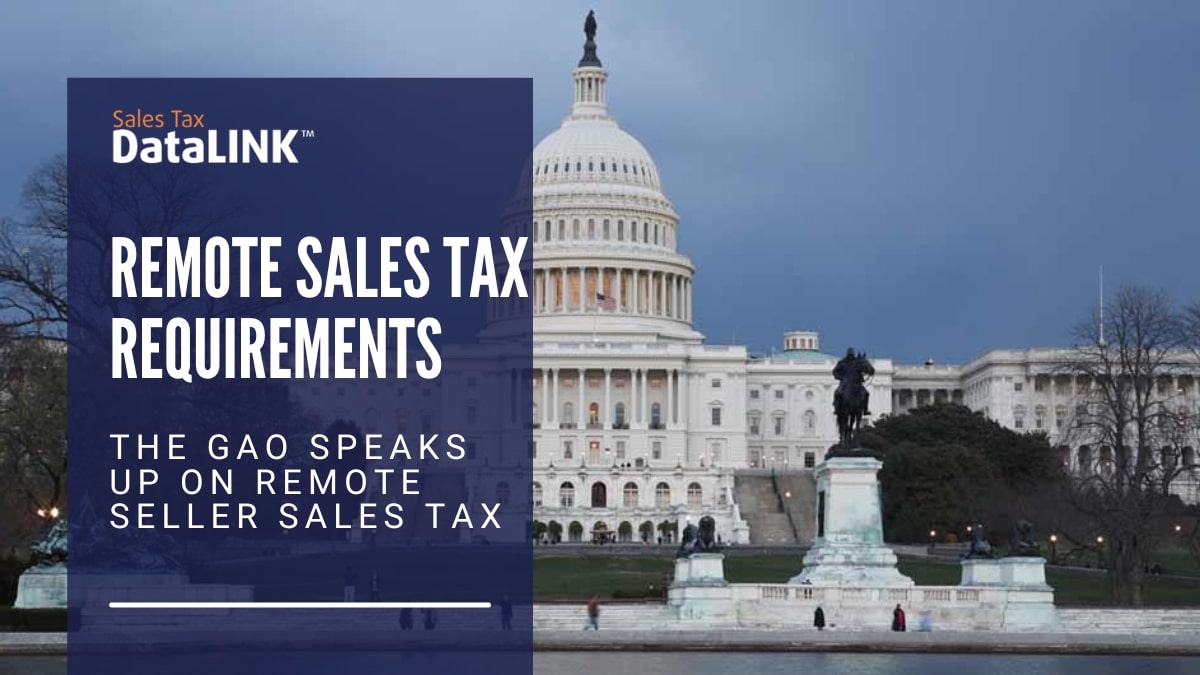The GAO speaks up on remote seller sales taxes
The Government Accountability Office is responsible for providing important facts to Congress so they can make the best legislative decisions. They have just released a report on the question of sales tax for remote sellers.
“Until recently,” they began, “states could not require e-commerce businesses operating out of state to collect taxes on sales to residents of their state unless the business had a physical presence in that state. This changed in 2018, and states quickly enacted remote sales tax requirements. However, this resulted in a complex patchwork of requirements—such as different exemptions for some small businesses in different states. Consequently, businesses face substantial compliance costs and uncertainty navigating these requirements.”
They made a clear recommendation: “We recommended that Congress consider establishing guidelines to guide state taxation of remote sales to resolve these issues.”
The Wayfair decision
Before 2018, a company was only required to collect and remit sales taxes if they had a physical nexus in a state: a warehouse, a store, or some other physical presence. Doing business in a state as a remote seller by mail order or similar transactions did not trigger nexus and did not require sales tax collection.
Congress spent years debating and discussing an “Amazon tax” or some other national sales tax requirement for remote sellers. As e-commerce became more important and online sales mounted, brick-and-mortar stores felt that they were getting the short end of the stick. It seemed to them that remote sellers got to present themselves as a cheaper option than physical stores because they didn’t have to collect sales tax.
At the same time, states and municipalities felt that they were leaving money on the table. Residents were supposed to pay a use tax, equivalent to sales tax when they bought from remote sellers, but only a tiny fraction of consumers ever did.
In 2018, the Supreme Court said that states were allowed to demand sales tax compliance from remote sellers. The court didn’t go into detail about the kinds of laws jurisdictions could make and they airily dismissed the idea that businesses would be burdened by the requirements. They just ruled that jurisdictions were allowed to make laws on the subject.
States and towns quickly jumped in and made those laws. However, as the GAO pointed out in their recent report, the hodgepodge of different laws created a “complex patchwork of requirements with wide variation.”
Recent Senate hearings made it clear that this patchwork of requirements does indeed create burdens on businesses.
Concerns
One of the major issues the GAO pointed out was the inequity of the new system. While Main Street shops felt that consumers might choose e-commerce in order to avoid sales tax, the new system definitely works out unevenly for different sellers. “GAO found that post-Wayfair multistate sellers must grapple with the patchwork of different requirements across the taxing jurisdictions with which they have economic nexus,” the report states, “whereas brick-and-mortar sellers generally must grapple only with the requirements of the jurisdictions in which they are physically located, regardless of the states in which their customers live.”
The inequity of the situation requires action.
They also found that businesses were making decisions based on the desire to avoid sales tax, rather than on sound business principles or market forces. “GAO found that remote sellers made behavioral changes arising from the need to divert resources away from business operations and investments and toward tax compliance,” they reported, “such as limiting the number of states into which they sell or the number of sales into some states to avoid some states’ remote sales tax requirements.”
Finally, they expressed concern that the use of resources has become inefficient. “GAO found that businesses are devoting substantial amounts of time and resources to multistate remote sales tax compliance; that the numerous requirements and variations across taxing jurisdictions made it difficult for businesses to understand their remote sales tax obligations; and that the administrative costs are borne in large part by businesses collecting from purchasers on behalf of the taxing jurisdictions.”
.All these outcomes are negative in terms of their effects on the national economy.
The GAO also noted that it is as yet unclear what variations on these laws are actually admissible under the U.S. Constitution. While there have been plenty of court challenges, the process of testing all the various laws could be an extremely lengthy one if it all has to go through the courts.
The proposed solutions
The GAO examined several different solutions. For example, they proposed that jurisdictions could only require sales tax compliance if they participate in a streamlined system with other states. Another option was to require each state to use “a single statewide point of registration, filing, administration, and audit.”
The GAO is clear that Congress is a better choice than the piecemeal operation of the courts to settle these issues. “While the right of states to levy taxes, and to empower their localities to do the same, is a well-founded principle of state sovereignty, under the Constitution’s Commerce Clause, Congress has the authority to regulate interstate commerce,” the report says. “The Supreme Court has stated that Congress has the “ultimate power to resolve” issues with taxation of remote sales. Federal legislation which puts nationwide parameters in place for state taxation of remote sales could help address the uncertainties and multistate complexities and improve the overall system.”
The report goes into quite a bit of detail on the problems and challenges created by the various requirements including differing thresholds, definitions, and filing dates, as well as the sheer number of different jurisdictions a business may have to deal with. They noted that there is no firm data on the number of companies subject to these requirements, but presented an estimate of about 68,000 remote sellers — more than 73% of which have fewer than 5 employees.
They found that remote sellers were paying more in sales taxes, spending more on the process, and in some cases had actually gone out of business as a result of the new rules.
At a minimum, the GAO wants to see the following from all states:
- Consistent definitions
- Consistent thresholds
- Consistent programs and processes
- Centralized programs and processes
Will Congress take action?
It’s uncertain whether or when Congress might take the GAO’s advice and fix what has become an unworkable system.
In the meantime, Sales Tax DataLINK can help. We offer the most accurate software, with the best customer service, at a predictable, transparent, affordable price.
We also offer complete outsourcing of your sales tax compliance. Call 479-715-4275 and let us impress you.




